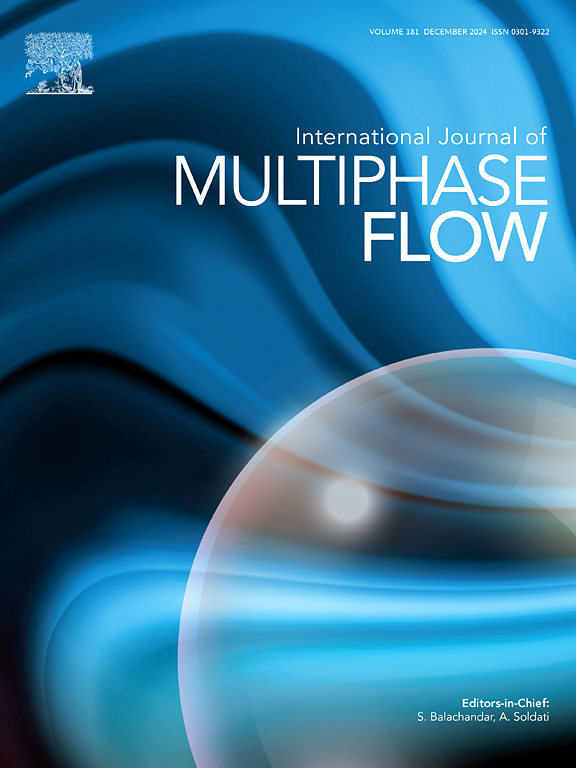改进的动力学,雾化和汽化模型的液氨喷雾模拟在不同的环境条件
IF 3.6
2区 工程技术
Q1 MECHANICS
International Journal of Multiphase Flow
Pub Date : 2025-04-02
DOI:10.1016/j.ijmultiphaseflow.2025.105225
引用次数: 0
摘要
液氨作为能量转换装置的燃料,由于其零二氧化碳排放的优势,呈现出诱人的前景。然而,液氨喷雾由于其独特的物理性质(如低沸点、低粘度、高汽化潜热),其动力学、雾化和相变行为与传统汽油和柴油燃料有很大不同,这使得在广泛的环境条件下对液氨喷雾进行精确模拟非常具有挑战性。为了解决这个问题,本研究提出了改进的阻力、雾化和汽化子模型,以更精确地模拟氨喷雾过程。考虑了有限粘度和液滴畸变(从长条形球体到扁圆形球体)的影响,以复制氨喷雾的阻力和汽化特性。此外,通过在破碎分散方程中引入液体粘度的影响,引入了一个更新的闪沸雾化模型来再现热破碎过程。利用最新的理论,提高了液滴内气泡的生长速度。通过对典型蒸发和闪沸工况下氨喷雾的实验与大涡模拟(LES)的对比,对改进模型的有效性进行了评价。结果表明,在蒸发条件下,新模型比传统模型预测的阻力系数更低,蒸发速率更高,能更准确地再现实验数据。此外,与其他模型相比,改进的闪沸雾化模型与新的阻力模型相结合,在预测闪沸喷雾的动力学和形态方面具有最高的准确性。经过广泛的验证,改进的喷雾模型可以在广泛的操作条件下有效地再现液氨喷雾的雾化和汽化特性。本文章由计算机程序翻译,如有差异,请以英文原文为准。

Improved dynamics, atomization, and vaporization models for liquid ammonia spray simulations under diverse ambient conditions
The use of liquid ammonia as fuel in energy conversion devices presents attractive prospects due to its advantage of zero carbon dioxide emissions. However, the dynamics, atomization, and phase change behaviors of liquid ammonia spray are significantly different from those of conventional gasoline and diesel fuels because of its unique physical properties (e.g., low boiling point, low viscosity, and high latent heat of vaporization), making an accurate simulation of liquid ammonia spray under a wide range of ambient conditions highly challenging. To address this, improved drag, atomization, and vaporization sub-models are proposed in this study to more precisely simulate the ammonia spray process. The effects of finite viscosity and droplet distortion (ranging from prolate spheroid to oblate spheroid) are considered to replicate the drag and vaporization characteristics of ammonia spray. Additionally, an updated flash-boiling atomization model is introduced to reproduce the thermal breakup process by introducing the influence of liquid viscosity in the breakup dispersion equation. The bubble growth rate within the liquid droplet is also enhanced using the latest theories. The validity of the improved models is evaluated through comparisons of experiments and large-eddy simulation (LES) of ammonia spray under typical evaporating and flash-boiling conditions. It is found that the new drag model predicts a lower drag coefficient and a higher evaporation rate than the traditional model under the evaporating conditions and can more accurately reproduce the experimental data. Moreover, the improved flash-boiling atomization model, coupled with the new drag model, demonstrates the highest accuracy in predicting spray dynamics and morphology of flash-boiling sprays compared to other models. After extensive validations, the improved spray models can effectively reproduce the atomization and vaporization characteristics of liquid ammonia sprays across a wide range of operating conditions.
求助全文
通过发布文献求助,成功后即可免费获取论文全文。
去求助
来源期刊
CiteScore
7.30
自引率
10.50%
发文量
244
审稿时长
4 months
期刊介绍:
The International Journal of Multiphase Flow publishes analytical, numerical and experimental articles of lasting interest. The scope of the journal includes all aspects of mass, momentum and energy exchange phenomena among different phases such as occur in disperse flows, gas–liquid and liquid–liquid flows, flows in porous media, boiling, granular flows and others.
The journal publishes full papers, brief communications and conference announcements.

 求助内容:
求助内容: 应助结果提醒方式:
应助结果提醒方式:


